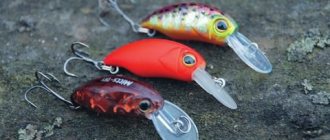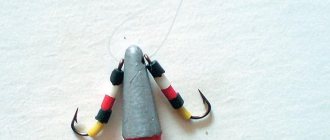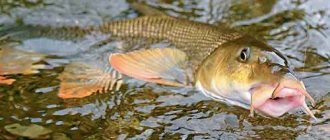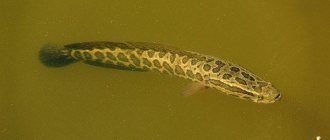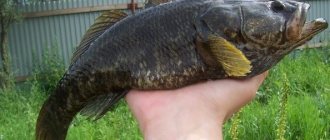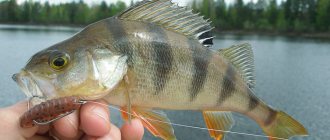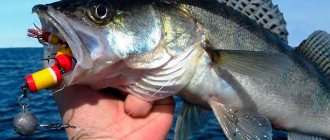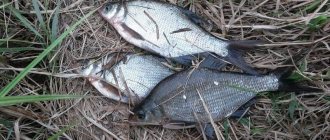Types of gear: when and what to use
To ensure that the bites follow each other, and you don’t have to get bored while waiting for prey, pay special attention to the choice of gear. Fishing rods using artificial baits of various colors and sizes, as well as lures, are popular among fishermen. The final choice of gear for perch in winter rests with the fisherman, based on personal experience and convenience, and the conditions of a particular reservoir.
Sparklers
Fishing rods of various designs and artificial baits, which have been popular for catching striped predators for several years now. The design is a small spinning rod equipped with a reel (multiplier or spinning reel) and a friction clutch (to maintain the integrity of the fishing line when catching large fish). One or more hooks are placed on the spoon.
The depth of the selected reservoir determines the weight of the bait: the shallower, the lighter. The average length of the spoon is about 5-6 cm, and its shape determines the game:
- straight – the bait is suitable exclusively for a vertical position, avoiding surprises hiding under the ice;
- with a bend - when swinging, the bait deviates from playing in a horizontal position;
- with holes and ribs - their vibrations perfectly attract the attention of fish;
- a soldered-in hard hook ensures stable play for the lure;
- displaced center of gravity - quick return to the original position.
To improve the bite, we recommend using additional equipment:
- beads, a piece of brightly colored cambric (red works well, it helps to concentrate the predator’s attention on the prey);
- threads of rich colors wound on a hook;
- decoys - attach a colorful element to the side leash of the spoon.
The “hatchet” is rightfully considered one of the most effective spinners. Outwardly, it resembles an ax or a sail made of a single plate.
Balance
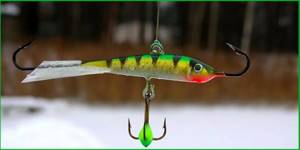
Another popular example of the most catchy gear for perch in winter, which is rightfully considered a “classic of the genre.” This bait is so loved by fishermen for a reason; in addition to the striped predator, you can catch other fish with it - pike, pike perch. As a standard, the balancer requires a fishing line of about 0.12 cm and a fishing rod with a long whip. The bait is attached to the fishing line with a clasp or using a loose loop. This fastening method has a great effect on his game, the rules of which we suggest you read below:
- lower the bait to the bottom;
- lift it using small strokes with an amplitude of +/- 30 cm;
- take short breaks between physical activity (about 5 seconds). Don't hesitate, but don't make hasty movements either. Monitor the behavior of the prey so as not to pull the bait out of its mouth and do not wait until the fish sinks into the water.
A few words about the size of the balancer and the shade. There is no correct color. Everything is selected according to weather conditions, turbidity of the reservoir, fishing depth, and fish activity. But the dimensions are influenced by quite understandable factors:
- in the dead of winter, use balancers up to 3 cm. This option is suitable for both cautious fish and for catching small individuals;
- 5-6 cm is the golden mean. Medium and large perches readily bite;
- bait from 7 cm is used for fishing at great depths or catching large fish.
For more than a hundred years in Russia, a proven method of catching perch in winter has been used - with a jig. There are several varieties of jigs with and without attachments. There are:
- nymph The length exceeds the width three times. The product is very light. Functions perfectly in standing water, when used in shallow reservoirs;
- flat tungsten. They fish with it in deep water and in strong currents. The weight is impressive, you need to have sufficient strength and dexterity to use this tackle;
- bug. The element consists of red copper and is light in weight. Its width is comparable to its length.
A nozzle-free jig is attached to the fishing line at a certain angle, while with a nozzle it is attached vertically.
Perch girders
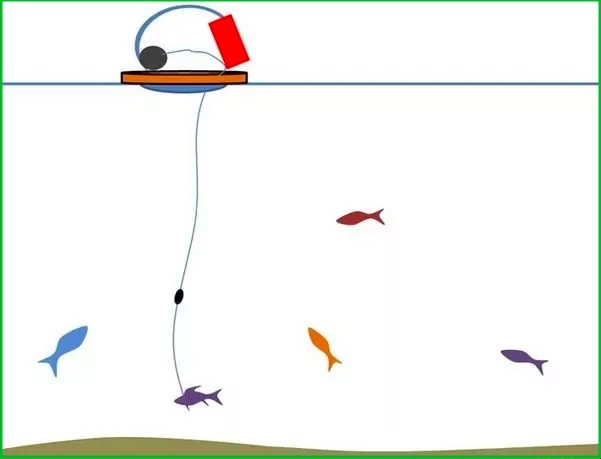
Not very popular among bass hunters. This method involves constant searching and moving. It justifies itself only when there is a lot of prey and there are no competitors (pike). The design is simple, it consists of a base with a reel, a hole for a fishing line and a bite alarm - a flag with a spring. The line is set to 0.15 mm. Use girders in the dead of winter; during periods of activity it is much more pleasant to work with balancers and spinners.
The distance between gear is no more than 50 meters. Otherwise, you will not have time to react quickly, the predator will wave its tail.
Avid anglers go beyond standard methods and choose methods that defy classification. Among them are bass fishing on Baldu or Honduras. The bulldozer is a massive bronze or brass sinker with hooks and additional elements of different colors. Among the advantages of such a bait I would like to highlight the following:
- there is no influence of river depth and current speed;
- thanks to the sound of bronze and brass when tapping on the bottom, the activity of living creatures increases;
- the load does not cling, it quickly sinks towards the bottom due to its weight;
- no need to waste time on the nozzle.
Honduras
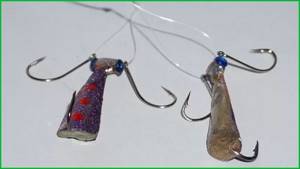
Imitation of dragonfly larvae, helps to catch large fish. It is a type of spinner in which, instead of a weight, a vertical spoon with a hole that is perpendicular to the hook is used.
Lures for fishing
This predator can be caught equally well on both rotating and oscillating spoons.
As for baits, there can be no clear recommendation or advice. It won’t be difficult to catch a “striper” using wobblers, proppers and other artificial baits.
The main rule of perch fishing is not to use too bulky or massive baits. The average weight of a spinner or wobbler is 5 grams. Another important feature that must be present in artificial lures for perch is shine.
Spinners, regardless of design, must have this quality. Wobblers that imitate whitebait should also have a reflective coating in attractive colors. Lures painted yellow and silver are most attractive to this predator.
Finding perch depending on the month
This fish remains active almost all year round, only occasionally going into hibernation. This usually happens when the ice crust has long covered the surface of the water and oxygen reserves are almost completely depleted. Perch moves to places where there is a lot of oxygen and a rich food supply. Sometimes during the day he changes his location several times. That is why it is important to thoroughly study the behavior of a predator.
With the arrival of winter, minke whales are found in shallow water, where the depth does not exceed several meters. Explore the reed beds; perch often use them as a stopping place, feeding on all sorts of small things there. If you see snags or rubble, go there, there is a high probability of bringing home something worthy of a delicious meal for dinner.
Are you sitting for more than 10-15 minutes and there is no bite? That means he won't exist. Change the hole or reduce the weight of the bait. Is it biting? This is a reason to concentrate on the process, putting aside all extraneous matters, since the flock is unlikely to stay for long.
In January, you will have to look for fish at great depths, where the temperature is less subject to sudden changes. Don’t expect a large flock; for the winter, individuals unite in groups of 5-7 in one group. In a stagnant body of water, the bite during this period is inconsistent.
If the month is too cold, look for predators near holes and depressions. In the dead of winter, he is slowed down, you have to poke the bait under his nose. If you find a hole in which there is a bite, drill the entire area around it. The closer spring is, the closer the fish move across the water area towards land.
There are a few tricks that you should pay attention to before going out on the ice. When selecting weather, choose a calm day. The predator begins to peck when there is slight frost (up to -20 degrees) and in the morning. Take time to adjust the sensitivity of the gear. Choose your bait wisely so that you don’t have to go out of your way to attract a large fish.
Choose small rivers from among the locations; here, catching them will require less effort and time. The main landmark is the coastline. Fallen trees, snags, thickets are places that must be explored. When fishing in large water areas, study the bottom topography by talking with local fishermen or re-reading posts on forums.
How to choose the right place to catch perch
So, when choosing a location, it is important to take into account weather conditions, time of day, and features of the reservoir. It is important to know that perch are more attracted to the sandy bottom, so first of all attention should be paid to these areas. At the beginning of summer, the predator is attracted to coastal areas and small bays, since it is here that schools of white fish rush to spawn closer to mid-June.
In mid-summer, perch is more often found in areas with a depth of up to a meter among thickets of underwater vegetation, where it ambushes fry. The most promising places for catching this predator are areas with snags and trees fallen into the water. In addition, the predator is attracted to edges and areas of the reservoir with an uneven rocky bottom.
Early in the morning or towards sunset, you can see the fry jumping out of the water next to bridge supports or right at the border of underwater vegetation and clear water. If this is discovered, you should immediately cast the bait in that direction. Seagulls, which always circle over the area where the striped predator hunts, can also help when searching for perch.
Large perch rarely approach the shore; more often they can be found at depth, namely at the exit from the hole. Promising places for catching trophy perch are not only deep holes, but also areas littered with snags and pools.
A little about bait
Perch is a predator and prefers food of animal origin. The following baits work well:
- Bloodworms combined with breadcrumbs are an absolute favorite. Rub the ingredients with your fingers, mix and throw into the pond;
- earthworms harvested in the fall. They must be stored in a container with soil, periodically moistening the soil. It is advisable to place the workpiece in the cellar, where there is good humidity. Before fishing
- mix 1 to 1 chopped worms and breading mixture;
- Roll fresh bread crumbs and pork blood into sausages. They store well in the refrigerator, wrapped in plastic wrap. Crumble the bait into the hole before you start fishing.
Attractants in any condition (paste, liquid, spray) are also a good solution as bait. They create a special cloud with an attractive smell, acting like a magnet on fish. For winter fishing, choose specimens that contain blood, crushed worms, fish oil, offal and anything that contains components of animal origin.
Go fishing with live bait. To do this, place the fry in a jar filled with water, close the lid and lower it into the drilled hole. This way you will attract a predator and the likelihood of a good catch will increase significantly.
The best trophies are caught with animal bait: a piece of fish, moths, larvae. It is advisable to use moving insects or periodically pull the bait towards you, creating a moving effect.
We assemble the tackle ourselves
For successful fishing for perch in winter, you can assemble your own tackle from a primitive set: comfortable rods (that will not freeze at sub-zero temperatures), a fishing line with a diameter of about 0.1 mm, a nod (boar hair is a suitable material that is clearly visible in the snow), a rewinder 0.3 g.
The sequence of actions is as follows:
- when calculating the length of the fishing line, we add up two values of the depth of the reservoir and a reserve (about 2-3 meters) in case of a break;
- wind it on a reel;
- We attach a nod to the end of the rod and pass the fishing line through it;
- We fix the jig on the fishing line.
Winter gear for perch
Returning to fishing, it should be noted that ice fishing is sometimes not a simple matter. Moreover, some believe that difficulties begin when there are no bites. However, this is not quite true. They are present just during bites, when you need to be confident in your fishing rods. Therefore, it is important that the winter tackle for perch is appropriate.
Today the most popular and effective are:
- Tackle with spinners and balancers.
- Tackle with jigs.
- Perch girders.
Each of them has its own advantages.
Perhaps someone didn’t know, but that rod, which uses a jig instead of bait, consists of a fishing rod. In turn, a reel is attached to it, on which the fishing line is wound, a nod and a whip. As for the nod, it is an excellent signal, notifying that some fish is interested in the bait. By the way, without it you won’t be able to play with the jig as needed, therefore, you can’t expect an excellent bite either.



